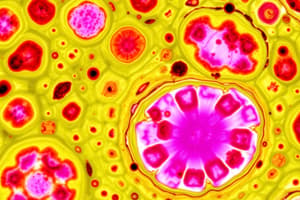Podcast
Questions and Answers
Which of the following accurately describes the composition of a cell?
Which of the following accurately describes the composition of a cell?
- A membrane containing only organelles
- Cytoplasm enclosed within a membrane (correct)
- Fluid matrix containing DNA and RNA
- A nucleus surrounded by a cytoplasm
What does the term 'cellula' refer to in the context of biology?
What does the term 'cellula' refer to in the context of biology?
- Function of cellular replication
- Component of prokaryotic cells
- Latin term meaning 'small room' (correct)
- Basic structural element of tissues
Which characteristic is not associated with all cells?
Which characteristic is not associated with all cells?
- Motility
- Photosynthesis (correct)
- Replication
- Protein synthesis
How long ago did cells first emerge on Earth?
How long ago did cells first emerge on Earth?
Which of the following statements is incorrect regarding cell visibility?
Which of the following statements is incorrect regarding cell visibility?
Which of the following is considered an organelle within a cell?
Which of the following is considered an organelle within a cell?
What is a primary function that all cells share?
What is a primary function that all cells share?
Which characteristic distinguishes cells from non-cellular forms of life?
Which characteristic distinguishes cells from non-cellular forms of life?
Which of the following statements about cells is true?
Which of the following statements about cells is true?
Which of the following describes a function of organelles in a cell?
Which of the following describes a function of organelles in a cell?
Flashcards are hidden until you start studying
Study Notes
Biosphere Overview
- The biosphere includes all living organisms on Earth, such as plants, animals, and bacteria.
- It differentiates Earth from other celestial bodies due to its life-sustaining environment.
Levels of Biological Organization
- Cell: The fundamental unit of life, comprising cytoplasm and membrane, often containing organelles.
- Tissue: A group of similar cells with a common function, serving a specific role in an organism.
- Organ: A structure formed from tissues working together, such as the heart or lungs.
- Organism: An individual living entity capable of growth, reproduction, and adaptation.
- Population: All individuals of the same species within a specific geographic area, such as a school of fish.
- Community: Different populations inhabiting the same area and interacting with one another.
- Ecosystem: A combination of living organisms and their physical environment, illustrating interactions within a habitat.
- Biome: A large-scale ecological community defined by specific climate conditions, vegetation, and wildlife.
- Biosphere: The cumulative global sum of all ecosystems, encompassing all living forms on Earth.
Biomes and Microbiomes
- A biome represents distinct geographical regions with unique climate and life forms, often spanning continents.
- Microbiomes refer to communities of microorganisms residing in specific, localized environments.
Biological Interactions
- Communities consist of various population interactions, including mutualism, commensalism, and predation.
- The complexity of ecosystems arises from the interactions between biotic (living) and abiotic (non-living) components.
Video Reference
- A video titled "Biological Levels in Biology: The World Tour" by Amoeba Sisters has gained significant viewership, exceeding 1.7 million views, likely providing educational insights on biological organization.
Studying That Suits You
Use AI to generate personalized quizzes and flashcards to suit your learning preferences.




